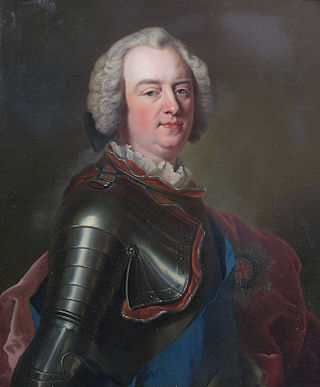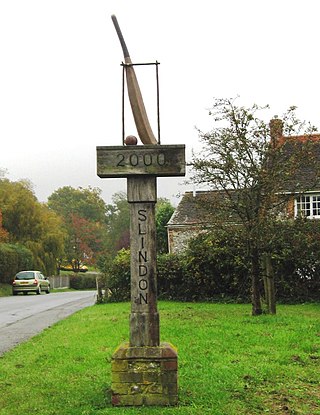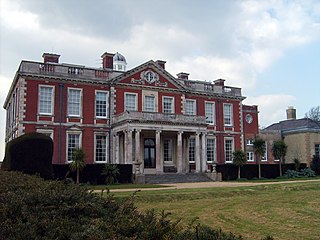
Charles Lennox, 1st Duke of Richmond, 1st Duke of Lennox, of Goodwood House near Chichester in Sussex, was the youngest of the seven illegitimate sons of King Charles II, and was that king's only son by his French-born mistress Louise de Kérouaille, Duchess of Portsmouth. He was appointed Hereditary Constable of Inverness Castle.

Charles Lennox, 2nd Duke of Richmond, 2nd Duke of Lennox, 2nd Duke of Aubigny, of Goodwood House near Chichester in Sussex, was a British nobleman and politician. He was the son of Charles Lennox, 1st Duke of Richmond, 1st Duke of Lennox, the youngest of the seven illegitimate sons of King Charles II. He was the most important of the early patrons of the game of cricket and did much to help its evolution from village cricket to first-class cricket.

The earliest definite reference to the sport of cricket is dated Monday, 17 January 1597. It is a deposition in the records of a legal case at Guildford, Surrey, regarding usage of a parcel of land. John Derrick, a coroner, testified that he had played cricket on the land when he was a boy in about 1550. Derrick's testimony is confirmation that the sport was being played by the middle of the 16th century, but its true origin is unknown. All that can be said with a fair degree of certainty is that its beginning was earlier than 1550, probably somewhere in south-east England within the counties of Kent, Sussex and Surrey. There have been suggestions that it can be traced to Flemish immigrants then resident in the area. The origin of the word cricket could derive from the Flemish word krick(-e), meaning a stick. Unlike other games with batsmen, bowlers and fielders, such as stoolball and rounders, cricket can only be played on relatively short grass, especially as the ball was delivered along the ground until the 1760s. Forest clearings and land where sheep had grazed would have been suitable places to play.
In the years from 1726 to 1750, cricket became an established sport in London and the south-eastern counties of England. In 1726, it was already a thriving sport in the south east and, though limited by the constraints of travel at the time, it was slowly gaining adherents in other parts of England, its growth accelerating with references being found in many counties. Having been essentially a rural pastime for well over a century, cricket became a focus for wealthy patrons and gamblers whose interests funded its growth throughout the 18th century.

The 1744 cricket season in England is remembered for the earliest known codification of the Laws of Cricket. This was drafted by members of several cricket clubs, though the code was not published until 1755. Much of its terminology such as no ball, over, toss, umpire and wicket remain in current use. The season is also notable for the two earliest known surviving match scorecards. The second of those matches, played on Monday, 18 June, was a celebrated event in which a Kent county team challenged an England team at the Artillery Ground, Kent winning by one wicket.

Richard Newland was an English cricketer of the mid-Georgian period who played for Slindon and Sussex under the patronage of Charles Lennox, 2nd Duke of Richmond. He also represented various England teams and, in some matches, led his own select team. The eldest of three cricketing brothers, he is generally recognised as one of cricket's greatest early players and has been called a pioneer of the sport.

Stansted Park is an Edwardian country house in the parish of Stoughton, West Sussex, England. It is near the city of Chichester, and also the village of Rowlands Castle to the west over the border in Hampshire.
County cricket teams representing Middlesex have been traced back to the 18th century, although for long periods the county was secondary to the London Cricket Club which played at the Artillery Ground. Middlesex teams played at various grounds throughout what is now the Greater London area. Islington and Uxbridge were often used but home matches were also played on Kennington Common and in Berkshire. Middlesex teams were less frequent in the 19th century until 1859 when the Walker family of Southgate became involved in county cricket.
The 1743 English cricket season was the 47th cricket season since the earliest recorded eleven-a-side match was played. Details have survived of 18 eleven-a-side and three single wicket matches.
The 1745 English cricket season was the second season following the earliest known codification of the Laws of Cricket.
The 1746 English cricket season was the third season following the earliest known codification of the Laws of Cricket.
The 1747 English cricket season was the fourth season following the earliest known codification of the Laws of Cricket.
The 1749 English cricket season was the sixth season following the earliest known codification of the Laws of Cricket.

The Dripping Pan is a football stadium in Lewes, England. It has been home to Lewes F.C. since their foundation in 1885. It had previously been used by Lewes Priory Cricket Club, though the ground itself had been used by the people of Lewes as an area for recreation, including athletics, as far back as written records exist.
Arundel Cricket Club are a cricket club in the town of Arundel in West Sussex, England, which was founded in 1704. The club's first XI plays in Division 1 of the West Sussex Invitation League They currently have three Saturday League sides, a Club (Friendly) XI and multiple Junior teams ranging from U10s to U16s.

Cricket in Sussex refers to the sport of cricket in relation to its participation and history within Sussex, England. One of the most popular sports in Sussex, it is commonly believed that cricket was developed in Sussex and the neighbouring counties of Kent and Surrey. Records from 1611 indicate the first time that the sport was documented in Sussex; this is also the first reference to cricket being played by adults. The first reference to women's cricket is also from Sussex and dates from 1677; a match between two Sussex women's teams playing in London is documented from 1747. Formed in 1839, Sussex County Cricket Club is believed to be the oldest professional sports club in the world and is the oldest of the county cricket clubs. Sussex players, including Jem Broadbridge and William Lillywhite were instrumental in bringing about the change from underarm bowling to roundarm bowling, which later developed into overarm bowling. For some time roundarm bowling was referred to as 'Sussex bowling'.
In English cricket, the years from 1751 to 1775 are notable for the rise of the Hambledon Club and the continuing spread of the sport across England. The Laws of Cricket underwent a re-codification in 1775, including the introduction of the leg before wicket rule and the addition of the third stump to the wicket.






